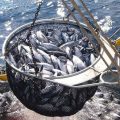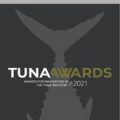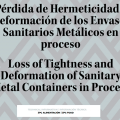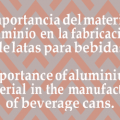The processing of tuna in frozen precooked loins, preserves, pouches, smoked or other presentations for direct human consumption, represents at present a sustained business alternative for the industrial fisheries sector.
It must be considered that the processing of this nobleman, but costly resource must be carried out with great efficiency, as well as with the appropriate equipment and technology, as the success of the operation will ultimately consist of obtaining high yields and good quality products.
Canned Packaging
The packaging of tuna pulp in cans is automatic nd
continuous, usually depending on the specifications of customers mixes the loms with the pieces and crumbs proportionally, as expected to higher percentage of scales in the can the sale price is lower. Depending on the machine used, the packaged weight or weight will be optimized,
grams of more in each can will represent at the end of the day less performance. It is also important to consider the pressure that the machine makes on the lomos to form the tuna pill, because at higher pressure there will be greater loss of liquids of
fish constitution with the consequent replenishment of white meat in order to reach the established weight. As a general rule at higher flake content in the pill the packaged weight may be lower in order to reach the drained weight requested by the customer.
Among the most common automatic packers in the middle we have the Carruthers (USA), FMC (Italy), Hermasa (Spain), Herfraga (Spain) and Luthi (USA). The Spanish and the American Luthi
are very accurate in terms of the packaged weight, the variable is about 2 grams, in terms of the presentation of the pillthe Spaniards have a better appearance and consistency for their high density, instead the Luthi does not generate a totally round pill, but because of its low density and consistency has greater possibility of absorption of liquids during storage with a higher yield.
Packers unload cans with the tuna pill directly to the cover liquid dispenser. Usually the packer dispenser and can packerare synchronized online and calculated to maintain the same capacity in terms of cans per minute.
As for pouches packaging or filling is manual; previously a mixture of white meat is prepared with water and oil if applicable, the product perfectly homogenized as a paste is introduced into the pouche through a funnel, thermally sealed and then
stowed and sent to the overpressure autoclaves for final sterilization.
Adding Canned Liquids
The addition of hot or cold topping liquids in the cans that come out of the packer is done automatically and continuously in dispensers of 4 or 5 turns, where water, oil and in some cases hydrolyzed soy protein or vegetable broth can be cascaded to each can that can increase the drained weight and therefore the weight of the pulp or white meat can be reduced during packaging. Currently the addition of hydrolyzed protein is not being used for Latin American market, on the contrary, Canada and USA still request it sporadically in their finished product specifications.
As a general rule it is preferable to heat liquids when the plant uses to sterilize conventional direct steam autoclaves, in the event that the plant uses overpressure autoclaves heating is not necessary
It is important to note that valves, pipes, floats, and so on in copper material should not be used in the equipment used for the preparation and dosing of co- ver liquids as this metal catalyzes the oxidation
of vegetable oils and in some cases discolors the natural color of white meat, it is preferable to use food grade stainless steel as an inert material.
Preserved closures
The closure or placement of the lid on the can is conti- nuous and as a critical point of control in the HACCP plan should be constantly monitored to achieve safe, airtight closures and within the limits specified by the
packaging manufacturer. Automatic shut-off machines are cu- rrently widely known and all must possess the steam flow or steam flow system for vacuum generation. The use of robust American fasteners such as Continental, FMC and Angelus that close up to 600 cans per minute for the 307 x 109 (83 x 40 mm) format is widespread, in the case of using high-speed lockers it is preferable that the fence can directly with the trawl chain to the boat holder or closing station to prevent liquids from falling which can affect the net weight required.
Preservative Sterilized
After closing the cans pass through a continuous washing machine and are accommodated in bas- kets with dividing sheets, the estiva of the cans has the advantage that can be greatly avoided the tossing or caramelizing of the surface of the pill that forms during sterilization.
As in the previous process the sterilization of cans is also a critical point of control in the HACCP plan of a canning company, especially because of the possibil- ity of survival of pathogenic spores of Clostridium botulinum that when reactivated can produce the deadly bot- ulinum toxin. This microorganism is mesophilic and its spores can be reactivated in tuna preserves at room temperature as it is a low acidity or low acid food with a stabilized final pH of approximately 6.2.
For this reason, standardization of the autoclave bank in accordance with the FDA Federal Code of Regulations (CFR) is of vital importance, siz- ing steam distribution pipes, vents, vent collec- tors, purges, respirators and other equipment, to obtain a uniform process temperature in each of the autoclaves and in each of the carriages throughout the sterilization time; this can be verified in detail with a tem- perature distribution study. Taking into account that any pos- sibility of botulinum poisoning in the consumer must
be eliminated, it is that the assessment of commercial infertility in canned products produced with the calculation of Fo is also essential; this is verified with a heat pene- tration study that must be performed for each can size, format, product, presenta- tion and in the most critical and adverse condition or in the worst case.
Logically, for performance and quality effect preserves should be sterilized only what is necessary to ensure public health, a Fo: 6 is considered normal for a low-acid food such as tuna preserves.
The author of this summary taking advantage of his status as a competent process authority before the FDA standardized the autoclave bank to several companies representative of the tuna sector to optimize short and sufficient processing, so that the loss of liquids in the sterilized and therefore the loss of drained weights is minimal. Logically as a support, temper- ature distribution and heat penetration studies are carried out to evaluate reached Fo levels.
General
After Tuna yield is directly proportional to its size and processing conditions, so that it can range from 44% for parts from 4 to 6 pounds to 48 and 50% for parts 25 pounds and up. So an average of 45% can be considered normal. In laboratory tests carried out by important transnational tuna in our environment they have been able to reach up to 53% performance.
It is important to mention that the disrecognise of processes and procedures that optimize the processing of tuna, can lead to drops in yields of up to 5%, which in an average plant of 100 tons per day at an approximate price of the raw material of
$1,600/TM, represents at a freehand cost approximately 4 mi- llion dollars per year, which can be at any given time the profit of the company. Now it is not only performance that is impor- tant, parallel to this must be implemented in the plant an inte- grated quality system with accreditations such as BRC (Global Standard for Food Safety), IFS (International Food Standard) and others that underpin haCCP as well as its pre-requirements of Good Manufacturing Practices (GMP) and Operational Pro- cedures and Sanitation Standards (SSOP). It is essential to have in the plant a traceability system implemented from the receipt of the raw material to the finished products including sales and shipments, currently in the traceability are included tuna boats and classified into two groups, origin or without origin for the European Community.
This summary on tuna processing succinctly reflects the most important recommendations that I have been suggesting as a consultant in the design and assembly of such plants.
CARLOS HERRERA ALFARO
Asesor de Mundolatas
Mundolatas Advisor














0 Comments